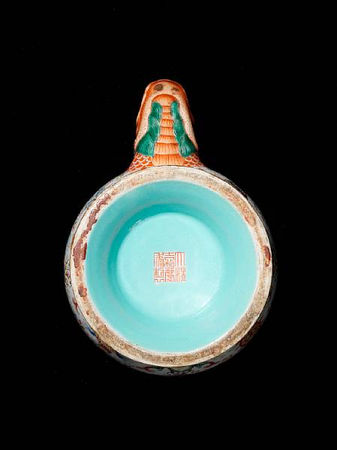A rare famille rose Tibetan-style ewer, penba hu. Iron-red Jiaqing seal mark and of the period
A rare famille rose Tibetan-style ewer, penba hu. Iron-red Jiaqing seal mark and of the period
The globular body rising from a high spreading foot ring, surmounted by an elaborately knopped neck below a thick disc-shaped mouth curving inwards towards a narrow opening, the applied s-shaped spout issuing from the gaping jaws of a moulded makara head, all painted with the bajixiang (Eight Buddhist Emblems) in famille rose, interspersed by leafy lotus flowers and scrolling and intertwining tendrils, framed by lotus lappets, ruyi-head motifs and segmented flower head motifs, the interior of the mouth and the base turquoise enamelled, stopping to reveal the iron-red seal mark. 19.4cm (7¾in) high. Estimate: £20,000 - 25,000
Provenance: an English private collection, Dorset
Note: An almost identical example was sold in these rooms, 6 November 2008, lot 8.
Ewers such as the present example are believed to have been produced for Buddhist altars in the palaces and temples of Beijing and Chengde, where the Qing Court's Summer retreat was located. It has been suggested that the exotic monster detail at the base of the spout indicates their use within a Tibetan-inspired Lamaist sect: see R.Kerr, Chinese Ceramics. Porcelain of the Qing Dynasty 1644-1911, London, 1986, p.114. It is also believed that the form bears relation to earlier bronze and other metal kundikas, as can be seen in the shape of a 15th century cloisonné enamel example from the Kitson Collection, illustrated by H.Garner, Chinese and Japanese Cloisonné Enamels, London, 1970, fig.16.
A very similar ewer but with beaded decoration at the mouth and bearing a Daoguang seal mark from the Simon Kwan Collection is illustrated by L.A.Cort and J.Stuart, Joined Colors. Decoration and Meaning in Chinese Porcelain, Washington D.C., 1993, Catalogue no.50 and also by The Chinese University of Hong Kong, Imperial Porcelain of Late Qing from the Kwan Collection, Hong Kong, 1983, Catalogue, no.62. A Qianlong mark and period example, also with the distinctive beaded decoration at the rims in the Victoria and Albert Museum, London, is illustrated in ibid., p.115, fig.101. Another related example from the Evelyn Annenberg Hall Collection was sold at Christie's New York, 29 March 2006, lot 172.
Doucai variations of this shape of ewer are also known; see a Qianlong mark and period example in the Asian Art Museum of San Francisco, illustrated by He Li, Chinese Ceramics. The New Standard Guide, London, 1996, p.295, fig.612, and a very similar example sold at Sotheby's Hong Kong, 2 May 2000, lot 677.
A Qianlong period underglaze-blue and iron-red ewer of the same form is illustrated in An Exhibition of Important Chinese Ceramics from the Robert Chang Collection, London, 1993, Catalogue, no.116, and was later sold at Christie's Hong Kong, 28 November 2006, lot 1318.
Bonham's. Fine Chinese Art, 14 May 2009. New Bond Street www.bonhams.com (Copyright © 2002-2009 Bonhams 1793 Ltd., Images and Text All Rights Reserved)

/https%3A%2F%2Fprofilepics.canalblog.com%2Fprofilepics%2F1%2F0%2F100183.jpg)






/http%3A%2F%2Fstorage.canalblog.com%2F98%2F08%2F119589%2F65863052_p.jpg)
/http%3A%2F%2Fstorage.canalblog.com%2F13%2F24%2F119589%2F65408549_p.jpg)
/http%3A%2F%2Fstorage.canalblog.com%2F26%2F55%2F119589%2F63221250_p.jpg)
/http%3A%2F%2Fstorage.canalblog.com%2F57%2F21%2F119589%2F63220730_p.jpg)